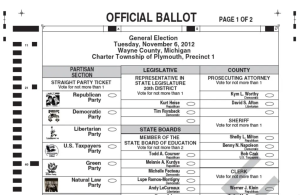Ballot Watermarks Already Exist
Genya Coulter

Ed. Note: We’re pleased to have election administration veteran and creator of #ElectionTwitter, Genya Coulter as our guest author to follow-up on an article last weekend on our parent’s site examining the proposed ballot anti-counterfeit watermarking legislation in front of the Arizona legislature and in at least three others states. Genya read our article and asked if she could offer some perspective worthy of more than a comment to the blog post. How could we possibly refuse? Here then, “ElectionBabe,” as the Twitterverse knows her 🤓 …
While the interest that AZ state Representative Finchem shows in ballot integrity is highly commendable, it’s worth noting some legal and logistical challenges with his proposed legislation that would surface in very short order.
First, watermarking on ballots adds to the cost of ballot printing. Larger jurisdictions may not be affected as much, but smaller jurisdictions would feel the pinch immediately. Election departments aren’t particularly well-funded in the first place.
Second, If only one company is licensed to print watermarked ballot stock, the backlog would be almost insurmountable for that firm. So, just imagine if this idea took off in a nationwide scale-up. There are around 10,000 separate election jurisdictions in the U.S. All of them would be requesting ballot stock at the same time, and by law, jurisdictions need to have three times as many ballots as there are registered voters in the jurisdiction, in case of need for a replacement ballot, ballot damage, or a ballot never arriving.
From a security perspective, all it would take is one good ICS/SCADA based cyber-attack aimed at the paper company’s industrial grade machinery to completely halt operations. (Think Stuxnet, on anabolic steroids.) Practically speaking, let’s not forget that paper stock thick enough to have a clearly defined watermark might be too thick for modern ballot printers or ballot scanners to read. And in my experience, I’ve seen Logic and Accuracy Tests derailed over ballot stock that isn’t the correct weight and smoothness; just sayin. 🤓
Third, and perhaps most important, ballot anti-counterfeiting techniques already exist.
That’s right, companies that are licensed to print election ballots use a specific type of metallic ink that can only be detected by the optical scanner. The anti-counterfeit marks (3 to be exact) are hidden in the ballot timing tracks and code channel, (the thick black bars that surround the margins on the ballot). The marks are specific to whichever election vendor’s election layout software and election technology are used, and each election definition uses a unique code channel specific to that election. These marks can be printed on pre-printed ballots or on ballot on demand.
I just want to add here (without intending to pile on to others’ observations), that anyone intending to run for Secretary of State where directing elections is a core competence or in the scope of responsibility, should probably know about these things if we’re to consider their candidacy credible. So, it is a bit surprising that an otherwise sensible initiative contains a proposal for anti-counterfeiting watermarks for ballots, when that capability is already in place. And a simple inquiry of the professionals who administer elections could’ve easily explained that and saved a lot of needless work.
Finally, as the Institute’s article explains in detail, none of these measures have anything to do with preventing voter fraud. Ballot fraud, maybe, but if a voter has registered illegally, or forges a signature, an anti-counterfeit watermark isn’t going to prevent it.
I concur with the OSET Institute’s read on this. The two concepts (fraudulent ballots and fraudulent casting of those ballots) are separate concerns; watermarks for the former will do nothing to stop the latter.




One response to “Ballot Watermarks Already Exist”